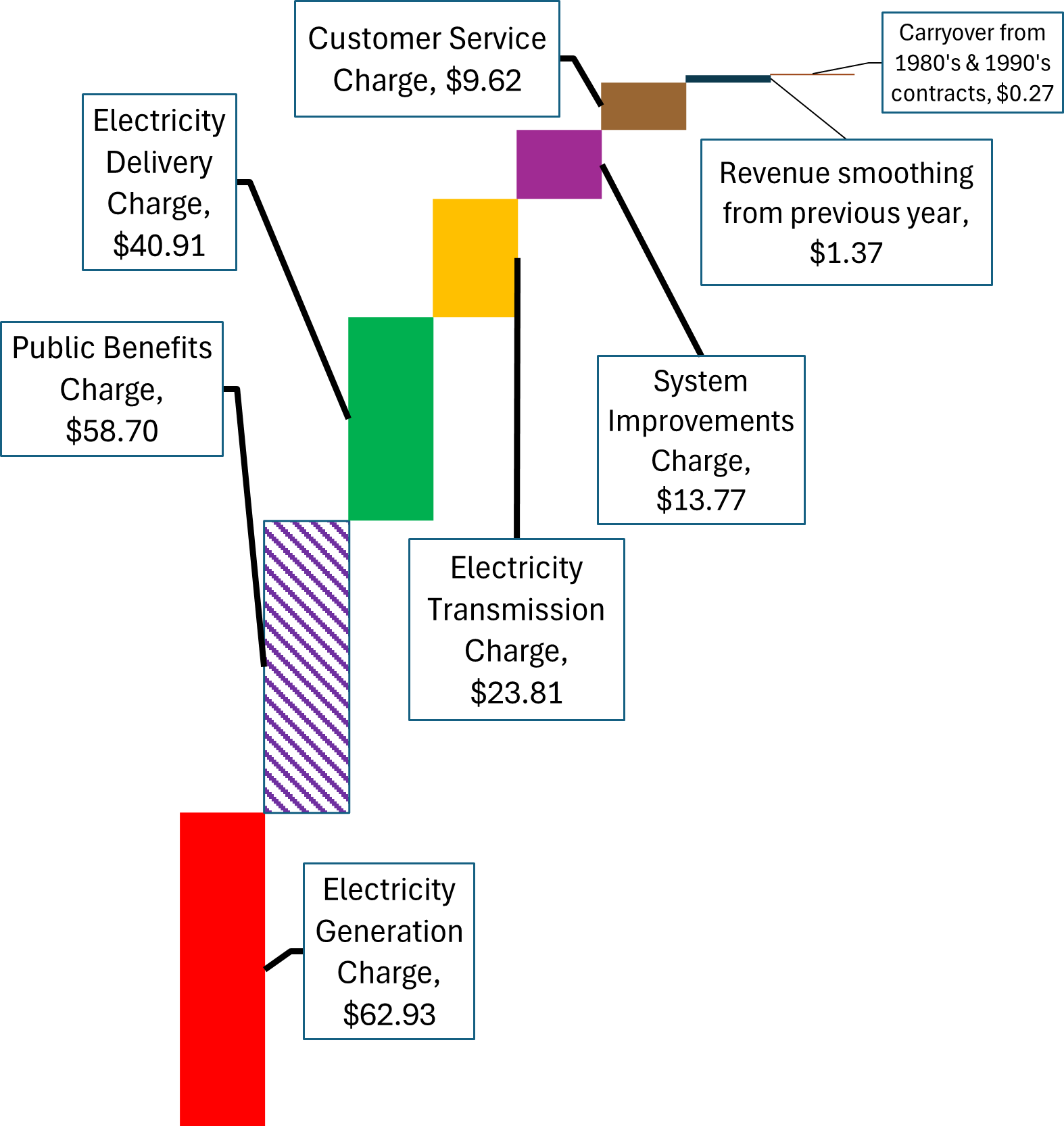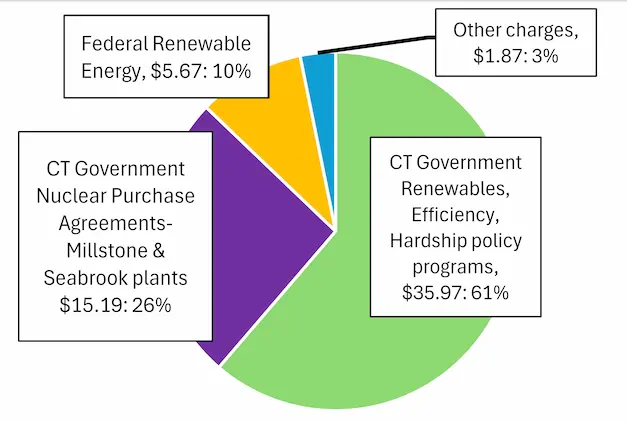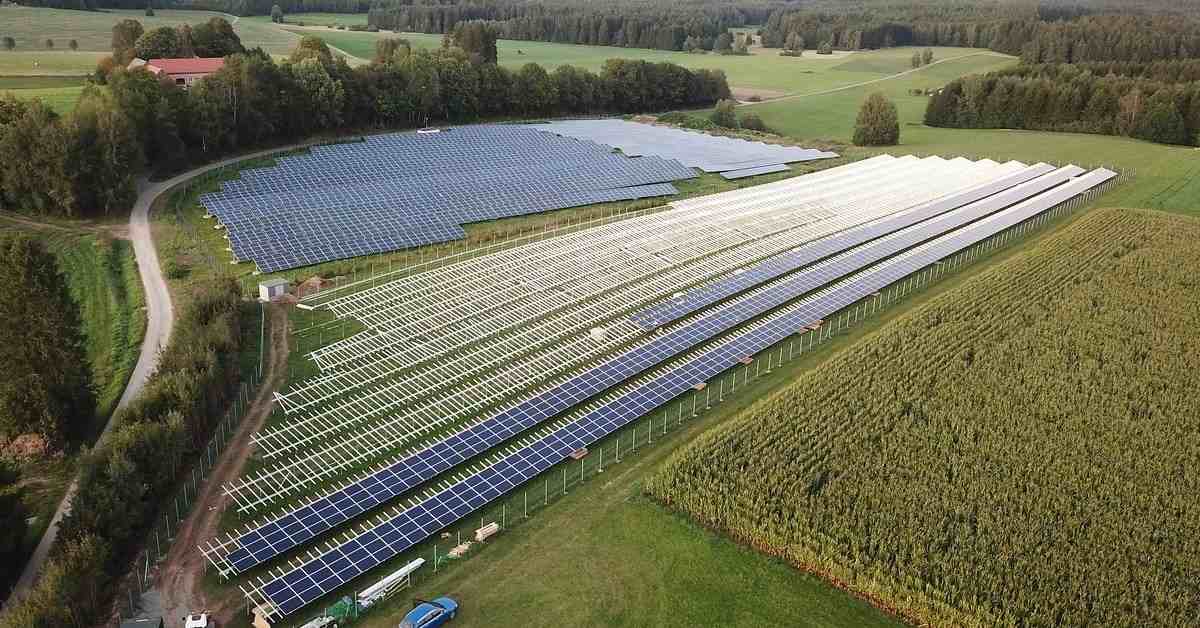Connecticut residents pay some of the highest electric bills in the country. But in the summer of 2024, ratepayers faced skyrocketing increases. Here’s why.
Along with a previously scheduled price hike, the Public Utilities Regulatory Authority (PURA), the state agency that oversees and regulates Connecticut’s utility companies, chose July 1 to increase the Public Benefits Charge to $58.70 for an average household (Figure 1). This is a charge that is proportional to a household’s electricity usage and funds the cost of government mandates for over a dozen policy programs. These costs are passed directly to consumers, providing no profits to power companies like Eversource or United Illuminating (UI).
YI has provided a breakdown for every charge on your electric bill (Figure 1), including a detailed breakdown of the Public Benefits Charge (Figure 2). The dollar figure in parentheses is calculated using the amount of electricity that an average Connecticut household consumes per month, 700 kilowatt hours (kWh).
The Charges Breakdown
Electricity Generation Supply Charge, Standard Service ($62.93). Charge for energy consumed to generate electricity. Supply rates change twice each year — on January 1 and July 1 — as demand for energy used to generate electricity increases or decreases. There was a 4% increase to this charge on July 1, 2024.
Public Benefit Charge ($58.70). This charge covers twenty individual charges related to specific policy programs, which have been implemented by the Connecticut General Assembly over the past three decades. This charge is broken down in more detail below.
Local Delivery Charge ($40.91). The cost of delivering power from the local distribution system to a household.
Transmission Charge ($23.81). Transmission is the cost of building, maintaining and operating the regional transmission system that brings electricity from power generators to the local distribution system.
Electric System Improvements Charge ($13.77). Cost of modernizing, strengthening, or protecting the electric grid.
Customer Service Charge ($9.62). Monthly flat fee for each ratepaying household.
Revenue Decoupling Mechanism ($1.37). Revenue smoothing from the previous year.
Competitive Transition Assessment Charge ($0.27). The federal and state government overhauled the regulatory and delivery system of electricity in the early 2000’s.

The Public Benefits Charge
The Green Slice
$35.97. Beginning in 1998, Connecticut’s General Assembly started passing legislation dealing with customer hardship cases while promoting renewable energy and energy efficiency. Most of these charges cost Connecticut residents, sometimes significantly. We include the monthly cost, hyperlinks to
relevant legislation, and year the legislation passed in each bullet point.
- $23.28. Systems Benefit Charge. CGS § 16-245l, (2000). This charge reimburses companies like Eversource to help customers who have difficulty paying their electric bills.
- $4.20. Conservation & Load Management Charge. CGS § 16-245m, 1998. Partially funds the state’s energy efficiency and weatherization programs.
- $3.98 PA 05-01 (2005), JSS & PA 07-242, Contracts for Differences
- $1.18 PA 11-80, § 107, § 127 (2011) Net LREC/ZREC Costs, Administrative Costs.
- $0.93 PA 05-01, JSS, § 8 (2005) Energy Independence Act Costs.
- $0.91 CGS § 16-245m (2001)- Project 150 EPAs.
- $0.73 PA 15-107 (2015), § 1(b), Project Costs.
- $0.70 (CGS § 16-245n, PA 23-170, § 20 (2023). Renewable Energy Investment Charge
- $0.14 PA 17-144 (2017), § 10
- $0.06 PA 15-194 (2001), Solar Home Renewable Energy Credits (SHREC) Program Costs
- $0.05 PURA rule, no CGA act (2021). (Docket 20-07-01) Residential Renewable Energy Solutions (RRES), 2022
- $0.04 PA 13-303 (2013), § 6 + 8, Class I Renewables Project
- $0.02 PA 15-107 (2015), §§ 6 & 7, § 1(b)
- $0.02 PA 19-35 (2019), Docket 17-06-02) Distributed Energy Resources (DER) Portal and Map
- $0.02 PURA rule, no CGA act (2021). (Docket 20-07-01) Non-Residential Renewable Energy Solutions Program (NRES),PA 21-162 (2021). Fuel Cell Electricity Generation CGS § 16-244y
- -$>0.01 PA 18-50 § 3 (2018), Plainfield Biomass Plant
- -$>0.01 CGS § 16-244y: Fuel Cell Electricity Generation
- -$0.03 Alternative Compliance Payments
- -$0.35. Regional Greenhouse Gas Initiative
- Unknown Cost. Electric vehicle charging subsidies. PURA Rule, no CGA Act, Docket 17-12-03 (adopted 2021, billing 2024)
The Purple Slice
$15.19. Nuclear power charge for purchase power agreements with Millstone & Seabrook nuclear plants: PA 17-3 (2017), JSS, Millstone. Connecticut contracted with Millstone to purchase 50% of its power at $50/mWh, from 2019 to 2029. While this deal cost ratepayers $64 million in 2023, it saved ratepayers $234 million in 2022. $265 million in under-collected charges is also included in this category.
The Yellow Slice
$5.67. Federal Qualifying Facility Renewables: Under the federal Public Utility Regulatory Policies Act of 1978, electricity delivery companies are required to purchase electricity generation from Qualifying Facilities, which produce 80 MW or less annually, using hydro, wind, solar, biomass, waste, geothermal or cogeneration technologies.
The Blue Slice
$1.87. Various Charges: This slice includes charges related to the 2024 Known and Measurable Expenses; Cancelled Units/Nonrefundable Payments; Consulting Fees; Revenues Collected in May and June 2024; and Independent System Operator New England (ISO-NE). ISO-NE charges electric distribution companies to send and receive power on the grid. (ISO-NE coordinates and monitors the electrical power system across Connecticut, Massachusetts, Rhode Island, New Hampshire, Maine and Vermont.)

What Are The Solutions?
- Consider using some of the federal ARPA (American Rescue Plan Act) funds to bring down the rate increases.
- Include hydro and nuclear power in Connecticut’s Renewable Portfolio Standard, allowing electricity providers to choose the lowest-cost sources of electricity generation available, rather than a mandatory minimum of expensive solar and wind power.
- Require that Public Benefits Charges on electric bills be approved by the General Assembly. Connecticut’s Public Utilities Regulatory Authority (PURA) recently authorized another $80 million to support Electric Vehicle (EV) charging rebates without needing the General Assembly’s approval.
- Restrict Power Purchase Agreements to rates at or below 150% of the wholesale price for electricity.
TO READ THE FULL REPORT:
- Click beneath report to expand screen for full view.
- Click on side arrows to flip the pages.
- Click on “+” or “-” to zoom in and out on pages.
- Click on bottom navigation bar to view the Table of Contents.

